God helmet
From Wikipedia,
The term God Helmet refers to an experimental
apparatus in neurotheology. The apparatus,
placed on the head of an experimental subject,
stimulates the brain with fluctuating magnetic
fields. Some subjects reported experiences
using the same words used to describe
spiritual experiences.[1] The leading researcher
in this area is Michael Persinger. Persinger
uses a modified snowmobile helmet
(the "Koren Helmet") that contains solenoids placed
over the temporal lobes, or a device nicknamed
the Octopus that uses solenoids, both of which
output "weak but complex" magnetic fields.
The Octopus uses solenoids around the whole
brain, in a circle just above subject's ears,
eyes and the bony ridge at the back of the
skull, a region that includes the temporal lobes.
Persinger reports that at least 80 percent of
his participants (working with the Koren Helmet)
experience a presence beside them in the
room, which ranges from a simple 'sensed
presence' to God. About one percent
experienced God, while many more
had less evocative, but still significant
experiences of 'another being'.
The apparatus uses magnetic fields, and not EMF
emissions, as is sometimes thought. Much of the
controversy surrounding the 'God Helmet' is due
to this misunderstanding. Further confusion has
appeared from the misperception that Persinger's
apparatus is an example of TMS (transcranial magnetic stimulation),
a clinical technique that employs magnetic fields
much stronger than the Koren Helmet, and that uses
pulsed 'trained' magnetic fields, instead of the
'complex magnetic fields' used in Persinger's research.
There is controversy as to the source of the effects
Persinger measured. In December 2004 Nature
reported that a group of Swedish researchers,
attempting to replicate the experiment under
double-blind conditions, were not able to verify the
effect.[2] Susan Blackmore, experimental psychologist
and experienced researcher of 'paranormal' experiences,
was reluctant to give up on the theory just yet.
She said "When I went to Persinger's lab and underwent
his procedures I had the most extraordinary experiences
I've ever had… I'll be surprised if it turns out to be a
placebo effect." [3] Persinger, however, takes issue with
the Swedish attempts to replicate his work. "They
didn't replicate it, not even close," he says.[cite this quote]
He argues that the Swedish group did not expose the
subjects to magnetic fields for long enough to produce
an effect. He also stresses that many of his studies
were indeed double blinded.[4]
Although the equipment and instructions were supplied
by Persinger to the Swedish team, later changes in
the software, made necessary by faster computers,
which the Swedish team didn't have, may have
confounded the Swedes' results. Both Persinger
and the Swedish team have published polemical
commentaries.
A report of an experiment on Richard Dawkins in 2003 said:
The experiment is based on the recent finding
that some patients with
temporal lobe epilepsy,
a neurological disorder caused by chaotic electrical
discharges in the temporal lobes of the brain,
seem to experience devout hallucinations that
bear a striking resemblance to the mystical
experiences of holy figures such as St Paul
and Moses. Such associations have been
noted by researchers for over a century,
including Dr.
Wilder Penfield's work, published in the 1950s.
[5]
Dawkins was reported not to have experienced a religious
feeling. The report said:
Dr Persinger explained his lack of effects.
Before donning the helmet, Prof Dawkins
had scored low on a psychological scale
measuring temporal lobe sensitivity.
[5]
There are others involved in the same lines of
research seen in Dr. Persinger's work. Research
by Mario Beauregard at University of Montreal has
shown religious and spiritual experiences to include
several brain regions, including the neurological regions
Persinger studies.[6] However, Dr. Beauregard's
work, unlike that of Dr. Persinger, does not include
inducing religious experiences, and is confined
to neural imaging Carmelite nuns while in prayer.
The correlation drawn between temporal lobe
epilepsy and religious experience, as discussed
by Persinger, has been questioned. The
auditory and visual hallucinations as well as
emotional states experienced by Temporal
Lobe epilepsy (TLE) patients during the seizure
state typically induce sensations of malcontent,
rather than ecstatic or pleasant sensations
that are integral to spiritual experience,
as noted by neurologist John R Hughes.
However, even though only a small percent
of TLE seizures include religious experiences,
the study of these individuals nevertheless
provides important evidence concerning the
neural basis for religious and mystic experiences.[7][8]
[edit] References
-
^ Template:Cite http://www.bioedonline.org/news/news-print.cfm?art=1424
-
^ Template:Cite http://www.laurentian.ca/Laurentian/Home/Departments
-
/Behavioural+Neuroscience/Correspondence/Persinger+Response.htm?Laurentian Lang=en-CA
-
^ a b Persuad, Raj (March 20, 2003). "Holy visions elude scientists". The Daily Telegraph. http://www.telegraph.co.uk/science/science-news/3306312/Holy-visions-elude-scientists.html. Retrieved January 1, 2010.
-
^ http://www.mapageweb.umontreal.ca/beauregm/Beauregard2006
-
_CarmelitesfMRI.pdf
-
^ Persinger MA (December 1983). "Religious and mystical experiences as artifacts of temporal lobe function: a general hypothesis". Perceptual and Motor Skills 57 (3 Pt 2): 1255–62. PMID 6664802.
-
^ Persinger MA (February 1993). "Paranormal and religious beliefs may be mediated differentially by subcortical and cortical phenomenological processes of the temporal (limbic) lobes". Perceptual and Motor Skills 76 (1): 247–51. PMID 8451133.
|
Understanding the Shakti
Using Alternating signals
The Shakti creates altered states of consciousness and spiritual change by applying magnetic signals to your head.
|
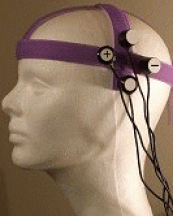 |
|
. |
|
It's based on the Koren Helmet, a technology
that has been studied in many laboratory experiments.
It's also appeared several times in television
documentaries about near-death experiences,
alien abductions, and altered-states of consciousness.
Art Bell has discussed it on his national radio show,
and it has been given the nickname "The God Helmet".
The first generation of this technology was developed
by Dr. Michael Peringer and Stan Koren.
The Shakti approximates the Koren helmet,
but does not duplicate it. That requires 8
independant channels. |
The magnetic fields get stronger and weaker,
mimicking patterns that appear in EEG traces.
Although they're still magnetic fields, they are
also 'magnetic signals', and that's what we'll be calling them. |
It works by switching the magnetic fields between
two sets of magnetic coils connected to the left and
right channels of your sound card. This brings the
areas within the magnetic fields to greater activity
than stationary fields could every achieve. |
Each side of the head has two pairs of coils.
When one of these pairs is producing the signals,
the area under it becomes active, and it becomes
quiet again when the other pair of coils is producing
the signals. This alternation helps the brain to become
active enough to produce a phenomenal experience -
one that most people would call spiritual. The temporal
lobes of the brain (as shown above) are the area most
likely to produce spiritual experiences from this kind
of stimulation, though the Shakti can be applied to
several areas of the brain. To have such experiences
using the Shakti, you will need to do your sessions
during sensory deprivation, especially silence.
Sessions done without silence can still have
worthwhile effects, but silence can make them
more "phenomenal". |
There are several ways of using Shakti that do
not depend on sensory deprivation at all. If you
use Shakti for mood enhancement, or meditation
enhancement, there is no need for sensory deprivation. |
Interestingly, laboratory studies have found that
the effects are most pronounced during times
of geomagnetic quiet. However, you don't need
to do your sessions under perfect conditions in
order for Shakti to work. The right conditions
help it work better. |
This technology can enhance your meditation,
Yoga, or other spiritual practice when Shakti sessions
are done an so that they end about an hour before
your spiritual practice begins. For this kind of
Shakti session, you don't need sensory deprivation. |
There is more to say about the Shakti, but the
best way to fully understand what it can do is
to read the rest of this page. |
What The Signals Do.
Shakti uses audio files to play the signals.
The 'sounds' have the same shape as an EEG signal -
one whose appearance shows the activation of a
particular structure (brain part). The magnetic
coils are plugged into the sound card, just like a
pair of speakers. When the audio file is played,
the coils produce magnetic fields whose shape
matches the shape of the original EEG trace.
The structure the signal 'belongs' to is activated.
Some people have wondered which frequencies
are used, and the answer is that Shakti's signals
are irregular 'bursts' containing many frequencies.
|
|
|
The wave forms
used in the
Shakti are
irregular.
Their shapes
can't be
expressed
with a frequency. |
|
|
|
Like Shakti (Irregular Bursts)
|
|
|
|
)
|
When the signals are played and the coils are
in place, the coils put out magnetic fields that
match the original EEG trace.
|
Magnetic Signals
|
|
|
|
|
|
|

|
|
|
|
EEG ("Brain Wave") traces are the source for most Shakti signals |
|
This is a single EEG trace. |
|
|
To use the Shakti effectively, you need to understand
something about the brain. Each signal has it's own
information page, but let's look at the source for
three of the signals - the amygdala, the hippocampus,
the caudate nucleus, and the septum.
There are other signals based on different
principles, included in Shakti For Windows.
These include the whole range of common
frequencies (using the Function Generator
included in the software), as well as some
based on lab experiences and discoveries
that don't 'target' only one brain part
You have two of each, one on each side.
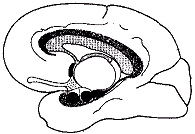 |
The AMYGDALA is an
emotional structure.
On one side, it supports
a broad range of positive
emotions, such as elation
(along with many other
functions). It also functions
to infuse our experiences
with a sense of meaningfulness.
On the other side, it supports
a broad range of negative
emotions, most importantly
fear (along with many other
functions). It can color our
experiences with a sense
of meaninglessness.
(Based on previous work
with the amygdala using
it's signal.) |
|
|
|
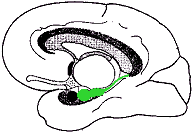 |
The HIPPOCAMPUS is a
cognitive, or 'thinking' structure.
On the one side, it supports
silent, non-verbal ways of
thinking, positive thoughts
and expectations, spatial
perceptions, and several
kinds of inner imaging,
including imagination,
visualization, and
pictorial memories (along
with many other functions).
On the other side, it supports
verbal skills, negative
thoughts and expectations,
and logical thought (along
with many other functions).
Based on previous work
with the hippocampus using
it's signal. |
|
|
|
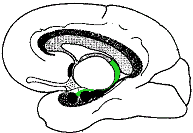 |
The CAUDATE NUCLEUS is a
somatic or 'bodily' structure.
On one side, it seems to
support arousal (including
anger, excitement, sexual
desire, and a sense of anticipation).
One the other, it supports
relaxation, calm, and even lethargy.
Based on preliminary reports
from a few people using this signal. |
|
|
|
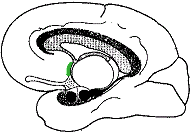 |
The SEPTUM is the brain's
"Pleasure Center".
It's one of the few brain
parts most people have
actually heard of.
It supports the experience
of pleasure, with a special
emphasis on sexual
pleasure (including Orgasm)
Preliminary reports from a
few people are consistent
with it's known role in
mediating sexual enjoyment. |
Each of these structures has a signal that
belongs only to it. The two signals appear
on an EEG (An electroencephalograph.
The signals that come out of these are also
called 'brain waves'.)
An EEG signal is a record of an electrical signal.
Shakti begins when these EEG signals are
converted into audio files that are 'played'
into magnetic coils. The coils turn the audio
output into magnetic signals.
The magnetic signals are applied to the head
at very low strength (close to what comes
out of a telephone receiver when you're
holding it next to your ear). Many of the
signals are short bursts, followed by
intervals of silence. The low strength
is used because experiemnts have
shown that these are the levels that work
best for this kind of neural technology.
Each signal speaks a language that only
one brain structure understands.
So only the one brain part responds.
It communicates with other parts, of course,
and they, in turn, also start responding.
You have two of each of these structures -
one on each side of the brain.
Shakti is applied using the structures own
signal, but only over the side of the head
where it supports something positive, or
over both sodes equally.
For the amygdala, it's almost always on the left,
and for the hippocampus, it's almost always
on the right.
For the septum and the caudate nucleus,
it's matter of personal preference which side is best.
When these structures respond, they put
the person in a positive altered state of consciousness.
Even though we can apply the wave forms
"symmetrically" (over both sides at the
same time), your brain probably doesn't work
symmetrically. For example, if you have low self-esteem,
you probably use your right side more. If you're prone
to irritability, you might be more active on the left side.
If you're very emotional, your amygdala's activity
might offset your hippocampal activity a bit.
If you think in pictures, you might have a busy
right hippocampus. If you think in words,
you might have a busier left hippocampus.
This means that some session designs may
not be as effective as others for you.
The things that affect the way individual
brains respond to Shakti often elate to long standing,
even lifetime, personality traits.
If targeted structure has a history of low activity,
the Shakti might produce quite a
marked experience for that person.
In addition to these signals, there are a few
newer ones, including one that alters the
binding factors for human consciousness,
based on years of lab work. This signal has
produced some profound experiences.
There is also the recent addition of a
signal derived from the Septum, the
Brain's "Pleasure center". Initial reports
indicate that it's effects are consistent with
the Septum's function - the capacity for
pleasure, especially sexual pleasure.
ALTERNATING SIGNALS
WHY ALTERNATE THE SIGNALS? -
To make the signals move and elicit more
activity than stationary signals ever could.
Each pair of coils has two poles.
One positive and one negative.
When the coils are actually producing
the signals, the area between the coils are stimulated.
Activity outside these areas is reduced.
With the alternating signals, this happens
too quickly for one of the two strips
to finish deactivating before the other begins to activate.
|
|
.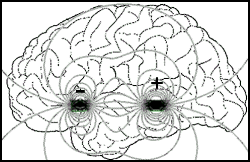 . .
|
|
|
|
|
The activity created by one pair of coils is pulled into the area between the second pair of coils. This process, called 'intrusion', shunts the activity back and forth between the two strips of brain between the coils. As the two interact, the overall activity becomes much more intense than could ever be produced by stationary fields. Alternating signals over the temporal lobes are the ones that were used in most of the reports made famous through TV documentaries. Conversations with Persinger confirmed that alternating signals are equivalent to rotating coils in most important respects. |
... |
|
|
From a BBC report: |
|
"How does Dr. Persinger induce artificially religious
experiences in his patients? |
|
"Dr. Persinger has designed a helmet that produces a
very weak rotating magnetic field of between ten nanotesla
and one microtesla over the temporal lobes of the brain.
This is placed on the subject's head and they are
placed in a quiet chamber while blindfolded.
So that there is no risk of 'suggestion', the only
information that the subjects are given is that
they are going in for a relaxation experiment.
Neither the subject nor the experimenter
carrying out the test has any idea of the true
purpose of the experiment. In addition to this,
the experiment is also run with the field
switched both off and on. This procedure
Dr. Persinger claims will induce an experience
in over 80% of test subjects." |
|
|
From New Scientist (4/21/01) |
|
"For several years, Persinger has been using a
technique ... to induce all sorts of surreal experiences
in ordinary people (New Scientist, 19 November 1994, p 29).
Through trial and error and a bit of educated guesswork,
he's found that a weak magnetic field--1 microtesla,
which is roughly that generated by a computer monitor--
rotating anticlockwise in a complex pattern about
the temporal lobes will cause four out of five people to
feel a spectral presence in the room with them." |
|
The power of moving magnetic signals is illustrated
in one study where 3 volunteers were given LSD and
were given sessions with the Koren Helmet.
When the coils were moving, the subjects saw
"blobs of white, purplish, or greenish-yellow lights ".
When the magnets (ordinary horseshoe magnets,
not the coils or signals used in Shakti For Windows)
weren't moving, the subjects didn't see these lights. |
|
|
And those were common magnets, not much
different from the kind you might have on your refrigerator.
|
|








 .
.